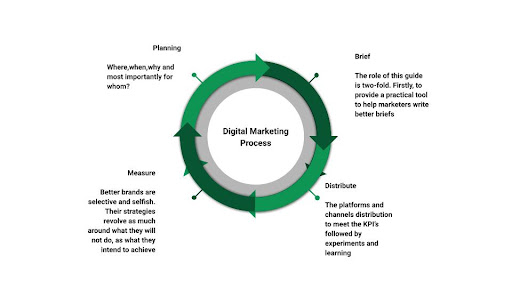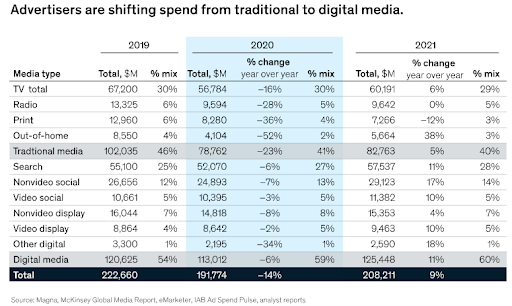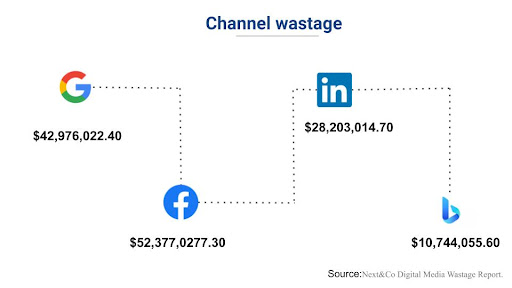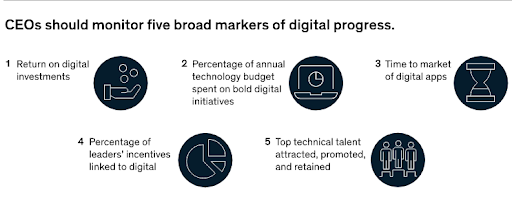A shocking statistic shows that 26% of marketing budgets are spent on wasted wrong channels and strategies (Ref) when we are all being asked to cut costs and adopt more sustainable practices. That’s why it’s a good idea to start by clarifying your strategy and reviewing your Marketing campaign planning and process.
The process of Digital landscape starts with the four principles
- Briefing
- Planning
- Distribution
- Measurement
Let’s go through the process of digital marketing through the lens of marketers, advertisers, planners, and managers.

We will examine a few basic aspects of digital marketing that will go a long way toward better ROI. As every penny matters!
Briefing: Why briefing is important
Briefings are triggers for creative thinking and a measure to meet the objective. This is a key point in transferring information from marketers to agencies. Briefings are key in guiding the creative process, which is inherently elusive and unpredictable. A brief written by a marketer for an agency should grab attention. Briefing, by definition, is giving the agent adequate information to present the best possible solution. However, briefings are often directionless at best and confusing at worst. Therefore, he has two roles in this guide.
First, by providing practical tools that help marketers craft better briefs backed by solid strategic thinking. And second, building a shared understanding of what makes a good brief between marketers and agencies. After all, we all want the same thing. It’s about working more efficiently and effectively to deliver better business results. This guide is about returning your thoughts to the briefing
“Writing bad briefs is the most expensive way to write advertising” Sir John Hegarty
Poor briefings do not allow agencies to solve problems or capitalize on opportunities marketers have identified. If the briefing is unclear, the agency is not sure what is expected of the briefing. At this point, a second guess begins. A good briefing guides creative thinking and is a neutral reference point for evaluating work. Often, the root cause is that marketers and agencies can’t agree on what a good brief looks like. 80% of marketers think they’re good at writing briefs. Only 10% of agencies agree (Ref).
No doubt, bad briefs cause many negative effects. They lead to confusion, shallow creative thinking, and often mediocre ideas. The result is dissatisfied customers, repetitive creative work, debriefings, demotivation, and ultimately a weak position in the marketplace. According to Better Briefs research, 14 out of 3 of all marketing budgets can be wasted on poor briefings and misdirected work. (Ref)
The best way of controlling media spending starts with an aligned brief.
There is a lot of pressure on agencies to create ideas that deliver a positive ROI and meet the objective of the campaign.
Do you know 4 in 5 agencies believe that marketers don’t understand what they need from a brief and with growing perusal the brand positioning takes another pothole road, (Ref)
“A brief is not about writing, it’s about thinking”
-Dave Trott
1) Defining Promotional Needs
A good brief focuses on the problem or opportunity that needs to be solved with creative work and serves as a compass for creative thinking. Clarify your advertising needs and justify your agency’s expectations. It’s the marketer’s responsibility to provide clear strategic direction in every briefing. You will soon see that agencies will benefit from this.
Note: Please clarify the ‘why’ for this briefing. Short story writers need to be clear about their decisions. A choice is required to determine whether the order is to acquire new customers, resell existing customers, or increase purchase frequency. When it comes to briefs, they are mutually exclusive. If more than one of these decisions needs to be made, multiple briefings are required.
2) Build the backbone
Goals from the budget. Your budget determines the size of your audience. Your audience size should be able to meet your goals within your budget. If your budget isn’t big enough, you can’t target everyone in your category. If one changes, the other two must also change. Lower budgets mean lower ambitious goals and fewer target audiences.
Note: It’s easy to justify investing in your company’s marketing (budget) when your goals and objectives are clearly defined.
3) Target the Right People
Not everyone is your target audience and not everyone will buy your product. Few brands have the budget to reach everyone, so most brands have to narrow their targeting. The definition of the target group should be distinctly different from the general population. It should be big enough to reach your goal. Marks must have or make valid rights to persuade them.
Note: A well-defined target audience is a clear picture of demographics, psychology, and needs or wants.
Briefing for Planning: In digital marketing failing to plan is planning to fail
New consumer behavior is forcing marketers to rethink their media spending plans.
Early assumptions were that life would return to normal and media teams could return to their normal budgeting and planning processes. But there are clear signs that there has been a lasting shift in consumer behavior as the pandemic accelerated the trend towards online channels that had already begun. Purchases increased from approximately 15% to 45% across most categories in the market, to the accuracy currently enabled by analytics. It’s not enough to just use the old plan and add or subtract percentages, as has often been done.

Five questions to answer before you finalize your media plan
1. Are You Spending The Right Money Against Your Business Goals?
A benchmark of total media spending as a percentage of revenue with industry peers is a good place to start. Of course, there are big differences between different industries and different sizes of companies. But only by showing how much their competitors are spending can a company decide whether spending more or less is the right approach based on its growth ambitions.
2. Do you have analytics to fine-tune your spending?
During these extraordinary times, it’s important to build flexibility into your media plans. In fact, accurate budgeting is built into regular adjustments based on monthly reviews. Regular performance reviews, such as the impact of spending on audience targeting and personalization, enable marketers to withdraw spending when marginal contributions decline and maintain or increase spending when contributions increase. You can Spending alignment between marketing and finance is also easier to achieve when there is room for constant review and reallocation.
3. Are You Spending Enough on Addressable Channels?
The traditional media planning process typically involves scheduling national television first, followed by major sports and other large audience events. After buying the early slots, they looked to other channels to fill the funnel gaps.
On average, traditional media accounted for 46% of his media budget in 2019, but by 2021 he is expected to drop to 40%. Also, more than half of ad buyers are shifting funds from broadcast (53%) and cable TV (52%). ) to a connected television (CTV).
4. Do you have the right agency mix to respond quickly?
With a clearer picture of what to spend, the planning process should also look closely at how that budget is actually being spent on campaigns. However, the typical campaign planning and execution process often take days or weeks instead of hours, an increasingly necessary timeframe for effectiveness.
5. Are you experimenting enough with strategic publishers?
When advertisers develop their media plans, the most visionary will work more closely with such publishers to Reach, First Party is looking at ways to leverage her data and analytical power. Some digital platforms are investing with retailers to help CPG companies understand how media drives store traffic and ROI. Traditional publishers are starting to follow suit, especially in markets where broadcast.
Just as consumer sentiment and behavior changed when the pandemic began, this will continue to change as communities go through cycles of temporary lockdowns and reopenings, making it difficult to predict the future with certainty. Advertisers should therefore prepare for change when planning their media spending. Executing an effective media plan is a critical step to achieving accurate budgeting, a greater focus on addressable channels, more flexible campaign delivery, and forging new relationships with publishers. is essential.
Distribute: The right distribution is a money machine
Here are some Unnecessary Brand Spending that is wasted
Brands need to be more aware of the dangers complacency creates, with more than $137.4 million being “wasted.” From January 2022 March quarter. According to the Next & Co Digital Media Wastage Report, this represents an average waste of 41% of media spend. The data overwhelmed Australia’s wastage of digital advertising spending, reaching $134.3 million, or 40%, in the first quarter. “Three key areas when it comes to how brands waste their digital media investments. (Ref)
The report examined 81 companies with digital advertising budgets ranging from $500,000 to $39 million. According to data gathered from Next&Co’s proprietary media auditing tool, Prometheus, retail brands reported the largest wastage of digital advertising dollars at approximately $32 million. Insurance was followed by $28 million, followed by finance ($26.5 million), real estate ($19.8 million), education ($16 million), and health ($14.7 million). Across all digital media channels, the most digital ad spend is on Facebook at $53 million, followed by Google at $45 million, LinkedIn at $28 million, and Bing at $10.7 million. “Unacceptable levels of wasted digital ad spend in the region, especially as digital ad spend in Southeast Asia reaches $4 billion and is expected to surge to one-third of all ad spend.” this is alarming. (Ref)

How to Control Unnecessary Brand Spending?
1. Reach a large audience, but not the target audience. Your target image.
Companies make the mistake of trying to get as much money as possible but ignore the fact that bigger is not always better. You should spend a little more or reach less (but be better targeted) matching the profile of your ideal customer.
2. Do not guide by another goal
I often see businesses compare their marketing and advertising strategies to what another local business is doing. The comparison is only effective if it is apple to apple. In these cases, they use companies with different goals and objectives or working in a completely different industry to guide their marketing strategy. It never ends well.
3. Keep evolving
So many companies take last year’s (or last decade’s) marketing strategy, discard it, and recycle it for this year’s marketing strategy. There is no other aspect of business – or indeed, of life – that yields the best results. A new look is always warranted. New technology, new trends, changing consumer mindsets, and new developments in your own business are all reasons to consider each year and every quarter a new beginning.
4. Spend not just to spend.
So you’ve spent some budget on marketing, developed a strategy, implemented the strategy, and still have money in the pot! You feel good about it, looking to use your final changes and end up throwing it into marketing tactics that don’t work. But why? Don’t spend money just to spend money. If you don’t use 100% of your marketing budget in a given season, save it for the next season and spend it on efforts that align with your strategy and are more likely to produce the desired results. would like.
5. No call to action is a massive failure
Last but not least, any marketing that doesn’t have a call to action – and not just any call to action, which will actually MOVE the customer – is a waste of time and money. It’s like shouting “Hey!” Once you get his or her attention, you’ll just stand there awkwardly. Always have a clear and compelling call to action.
Measure: Measuremetrics is a way to move forward

Which channels should be credited for converting prospects into buyers, and how much credit should each channel have? Understanding the contribution of each touchpoint as the customer journey becomes more complex Doing can mean the difference between business growth and a failed marketing effort.
Once you’ve correctly determined the touchpoints that have the greatest impact on purchasing decisions, you can optimize your campaigns to maximize revenue. But marketing also needs to identify users who convert based on his message and those who will buy anyway. No single measurement tool can fully capture all media exposure, conversion, and sales data and provide ongoing actionable insights. To be successful, a combined approach must be used to measure media impact across all channels. Combine multiple methods for best results. There is no one-size-fits-all approach to measuring marketing impact per channel, so it is best to use a combined system tailored to your specific situation and goals.
Tips: Use simple words in a briefing
Only 5% of agencies believe briefings received from clients are clear and concise. A good briefing requires reductive thinking. It should be short. It should have everything you need and nothing more.
Spend more time downsizing
This is because most agencies feel that the briefing they receive from the brand is not concise enough. Practice the art of sacrifice. Put all the extra information in the appendix.
Don’t be in a hurry
Give campaigns time to learn, strategies, and perform. The digital nomads need to understand the performance, KPI, and user behavior. It’s not an overnight thing that changes sand to gold
Read the data
The data dictates where to go—as in what platforms to focus your attention on when to post, what kind of content, etc. It also helps you extend a more personalized experience to every customer and potential customer.
Create a Blue ocean strategy
This strategy aims to capture new demand and render competition pointless by presenting high-performing products. The Indian Premier League (IPL) has reinvented the national cricket league by transforming the lengthy “Gentleman’s Game” into an exciting three-hour sports drama starring Bollywood stars.


